

LOST CAUSES
LOST CAUSE - a cause that has lost all prospect of success (Merriam-Webster Online)
Trying to make the most of the natural activity and diversity of springtime in Connecticut, I try to get out frequently near my home in search of subjects to photograph. Sometimes I feel pressure to be as productive as possible during this short time of plenty. So after a busy week without much time for the outdoors, I was anxious to head out and find something to shoot. I set out on one of my favored routes in the afternoon, through the woods of Lyme and East Lyme, despite the dreary weather. After a few fruitless stops at some of the many land trust preserves and state forest areas on my route, I decided to pack it in, thinking it was a lost cause.
On my way home, I caught a glimpse of the familiar football shape of a hawk through the trees and hit the brakes. Fortunately, these roads are lightly traveled, and I backed up to see what kind of hawk it was. A Broad-winged Hawk was hunting from a perch in a wooded swamp about 50 yards away, so I pulled off the road to see if I could get a picture. The hawk cast a few curious glances my way as I inched my car back and forth, trying to find a clear view of it through the trees, but continued its hunt. While searching for a vantage point to photograph the too-distant hawk through the jumble of gray trees, shooting up into the dull gray sky I was thinking "I'm really getting desperate here".
After finally settling on a spot, training my long lens with teleconverter out the car window balanced on a jacket (I've never been able to justify spending so much on a specialized been bag for such purposes) the seconds had turned to minutes. Finding an exposure that I could shoot hand held and captured enough detail in the dark hawk while not completely blowing out the sky added more time. That the hawk was still there seemed a miracle, as I waited even longer for moments when would turn its head to the side or back toward me. Finally, a pick-up truck drove by, and the driver give me that "what the heck are you doing" look. By then I had taken more than 100 pictures and my thoughts echoed his look, "why am I wasting so much time on this picture, it's obviously a lost cause".
A week later, as I was catching up on editing and came across these raw pictures, I had similar sentiments and deleted most of them because they weren't sharp enough. I opened one of the keepers to see if I could do anything in the processing to transform the dull gray image and a glimmer of hope appeared. Photography is extremely subjective, and opinions will always vary about what makes a good photograph. I'm not sure whether it's because I had no hope for these pictures, or that the hints of color from the emerging leaves break up the gray linear composition, or that it shows the hawk in its habitat, doing what it does, but this turned into one of my favorite pictures from this spring. The popular trend in wildlife photography has been toward the sharp, clean close-ups with soft, out of focus background and no distracting elements. I like those kind of pictures but find they get boring pretty quickly. There is something rewarding about being able to organize the chaos that nature sometimes presents, and capture something a little less obvious that makes you look a little a little longer and closer at an image. It gives hope to all the lost causes out there.


THE YARDBIRDS
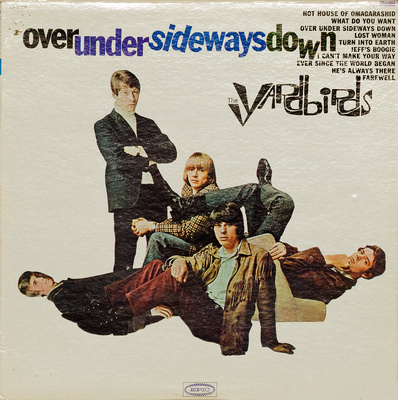

No, not the English rock supergroup of the 1960's that launched the careers of guitar legends Eric Clapton, Jeff Beck and Jimmy Page. At the risk of dating myself, they were one of my favorite bands as a teenager (I still have my original Mono album) even though they were over by the time I was five years old. I wonder why they named themselves The Yardbirds, since it seems to imply the common or ordinary. Fast forward four decades or so and I'm still into the yardbirds.
I've been photographing birds in my yard for 20 years and have not done too bad considering my modest plot. Each new season brings a new batch of subjects, although it's usually the same new batch year after year, and they have become ordinary to me over time. Reports in the spring of people seeing migrant warblers like Cape Mays and Blackburnians in their Connecticut yards always turns me a bit green with envy ...... "the grass is always greener". But each new year holds new hope, so I keep at it.
After a cold spring, the season kicked off for me on Mother's Day weekend, when I walked out the front door to get a package and scattered a House Finch from the shrubs next to the landing. The reason for its close proximity stared me right in the face, a nest with two chicks in the back of a dwarf Alberta Spruce. I went inside and watched from the window for a while as the adults came and went, feeding the chicks. I decided to to set up a camera under the eaves and trigger it remotely from inside. After a couple failed attempts at framing and focusing (I couldn't look through the back of the camera since it was up against the house) I finally got it right.
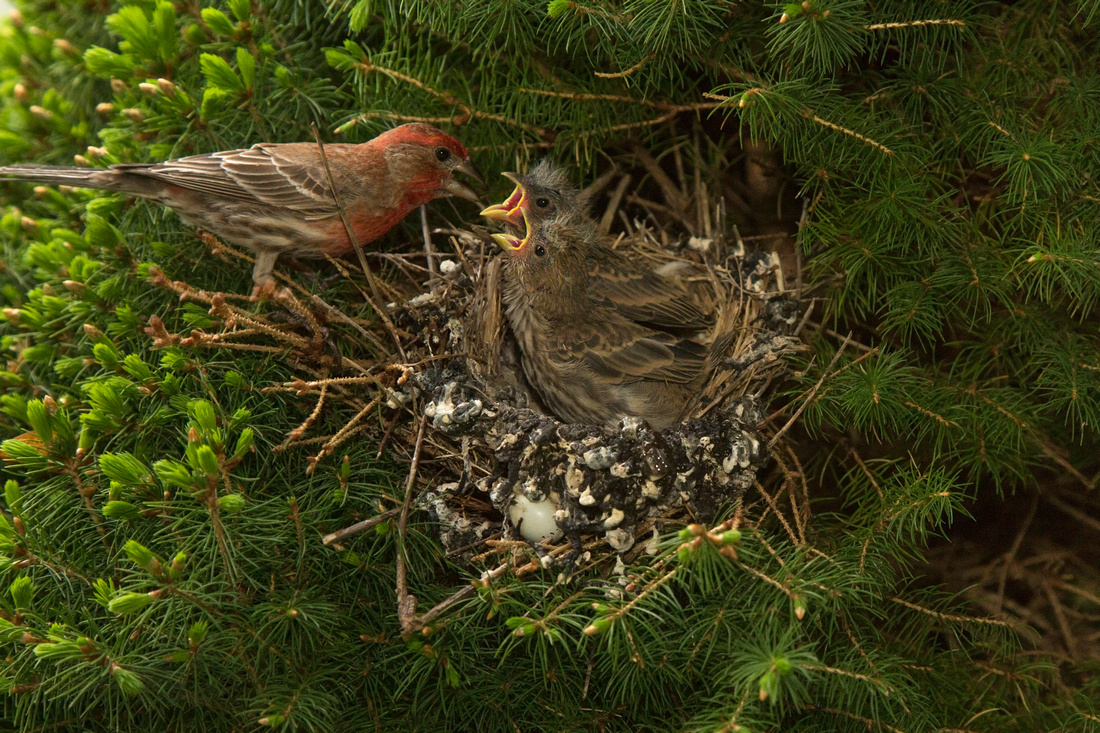

The nest was pretty ugly since the adults stop removing the chick's fecal sacs, and and it was ringed with excrement. An unhatched egg was buried under a pile of it, as well. The adults also never brought insects, like other birds do, to feed the chicks. Instead, it was some ground up stuff they regurgitated. I've since learned that House Finches feed their chicks mostly plant matter, and dandelion seeds are a favorite food. Sadly, my lawn has plenty of them. While I watched from the window, waiting for the adults to return, I noticed another pair had a nest lower down in the same bush, buried way inside and a third pair nested in a similar tree about 10 yards away. Later in the day I took a walk around the block with my wife and we scared several blackbirds from a neighbors lawn. One turned out to be a male Bobolink and when we got back around to our house it was in our yard. A new yard bird added to the list!
The next few days the migration seemed to peek in Connecticut, and we had a bunch of new arrivals in our yard. Among them, a pair of Great Crested Flycatchers that were dust bathing in our garden and a House Wren that plucked fibers from the frayed net of my son's lacrosse goal. One day as I was loading my gear into the car to go to a job, I heard a high pitched song in the back yard. I walked around back and saw the pear tree, in full blossom, dripping with a half dozen or more Blackpoll Warblers. I grabbed a few quick shots and headed to work, hoping they would still be around when I got back.
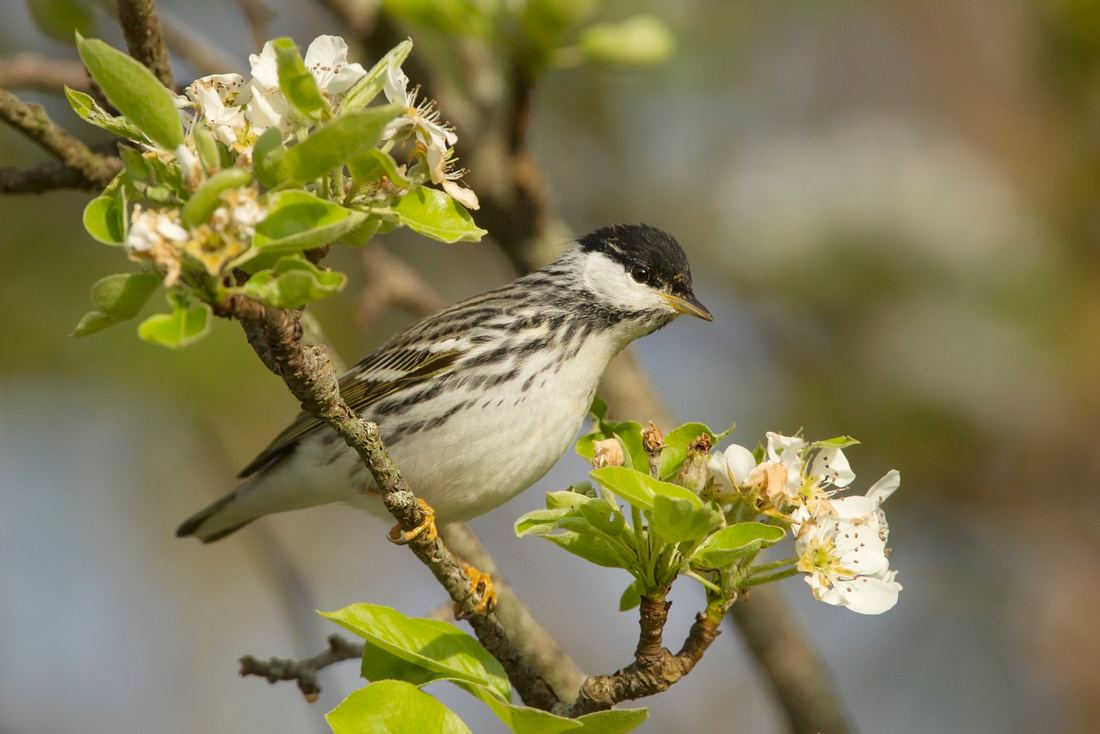

The good thing about my yard is that there are several fruit trees, a pear, two apples and a cherry that were planted 60 years ago by my grandparents. Behind them are two tall oaks and closer to the house are a few crabapple trees that I planted to provide shade for our two dogs, who have since departed. The bad thing about it is that we're in eastern Connecticut near the coast (I know .... you're thinking why is that bad?) The reason it's bad is that we get far fewer spring migrants than central or western Connecticut. It's most likely just geography, but another reason might be that because of the cool ocean air the trees leaf out here at least a week later than other parts of the state, so most of the migrant songbirds I see in our yard are towards the tail end of the season. The fruit trees, however, usually blossom in early May before we get many migrants. Some years we have orioles feeding in the blossoms but if it's a warm spring, the blossoms are often gone even before the orioles return.
So back to my pear tree and the Blackpolls. They were still there when I got home, and I spent the last hour of sunlight photographing them while "hiding" behind the aforementioned lacrosse goal. The cold spring this year held the tree blossoms back until mid-May and the birds were here to capitalize. Timing is everything. The next morning I went out early and even more had warblers joined the feeding frenzy, Blackpolls were everywhere. We often get a few late in migration way up in the oak trees but these were at eye level!


Joining the Blackpolls were a couple Magnolia Warblers, several Northern Parulas, a few resident Yellow Warblers, Baltimore Orioles, and an immature Orchard Oriole. The next couple days it was tough to get much processing work done, because every time I got up from the computer I'd see more birds and get sidetracked photographing them. There was also a Worm-eating Warbler, a first time yardbird, and Common Yellowthroats that I never got clear shots of. I also heard a Blue-winged Warbler singing, but never saw it.


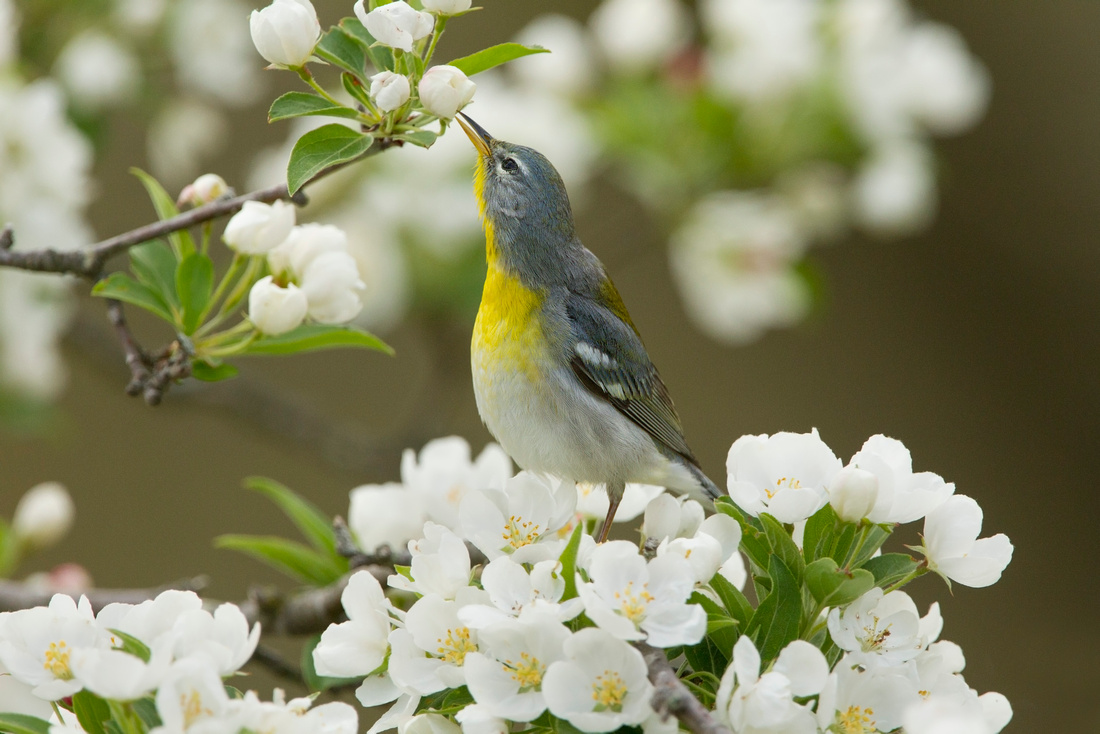

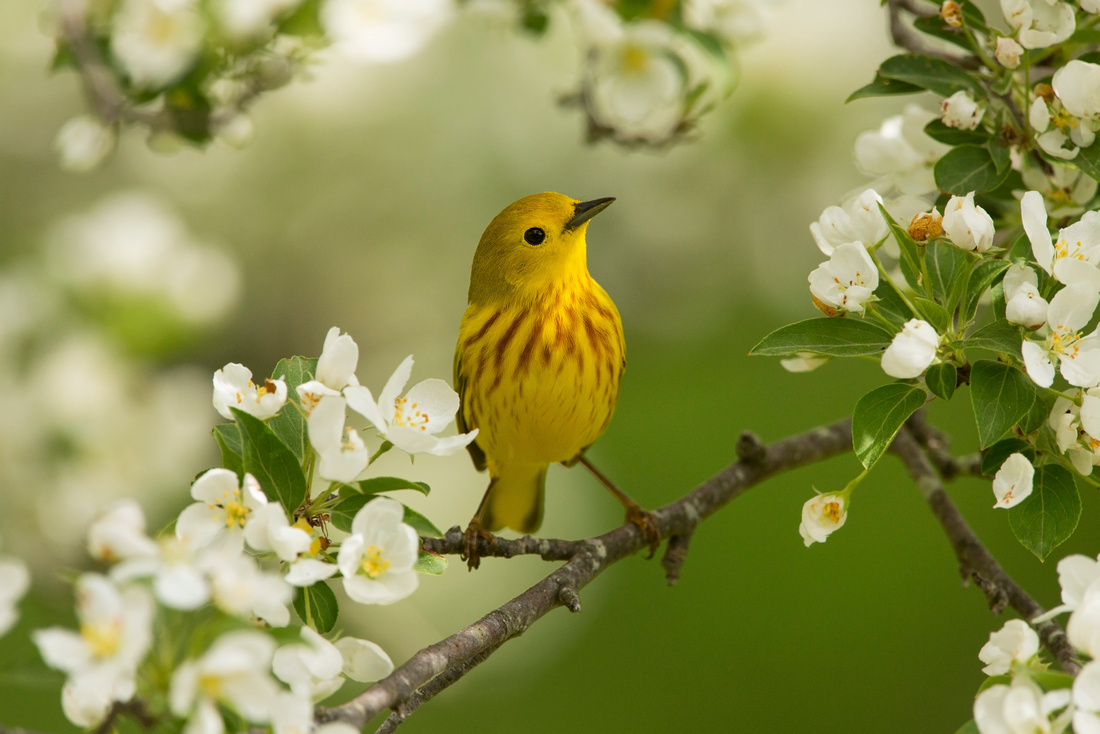

What the birds are actually eating in the tree blossoms appear to be small worms, although some birds tear off the whole flower to get at them. I was able to capture several shots of birds with small worms in their beaks.




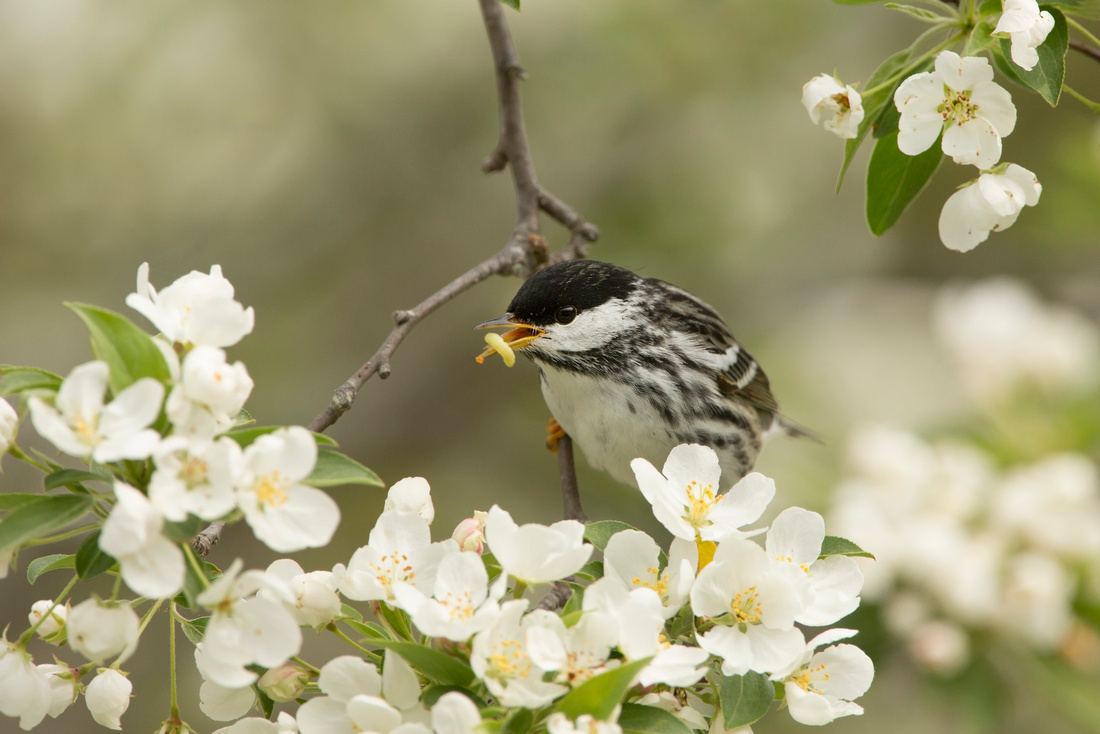
 The cherry on top of the whole episode was that two of the flowering crabapple trees are right next to the house, and I was able to shoot from inside, through open windows. Using the camera on quiet mode, the shutter made almost no sound and the birds took no notice of me as they foraged undisturbed. As a photographer, you know things are going well you have to make the tough decisions about what to shoot. Do I focus on the female Baltimore Oriole hanging upside down in the white blossoms, with the clean background?
The cherry on top of the whole episode was that two of the flowering crabapple trees are right next to the house, and I was able to shoot from inside, through open windows. Using the camera on quiet mode, the shutter made almost no sound and the birds took no notice of me as they foraged undisturbed. As a photographer, you know things are going well you have to make the tough decisions about what to shoot. Do I focus on the female Baltimore Oriole hanging upside down in the white blossoms, with the clean background?
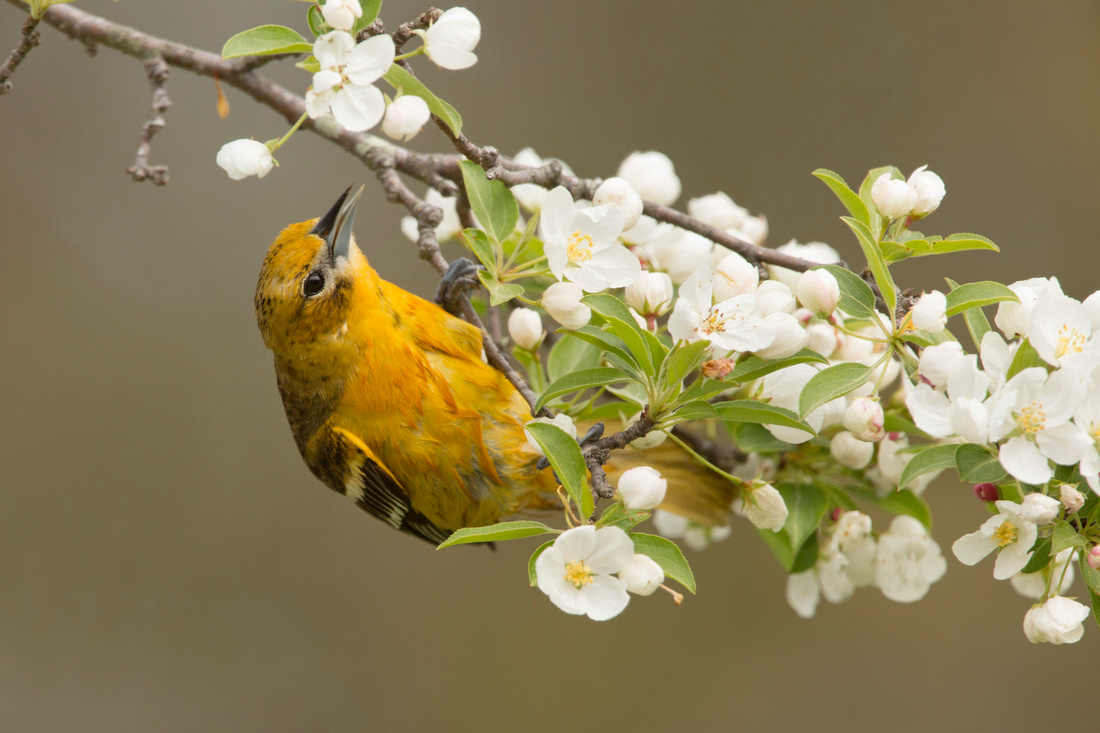

...... or the striking male that's just below it?


..... or better yet, the Blackpoll Warbler that's even closer ....
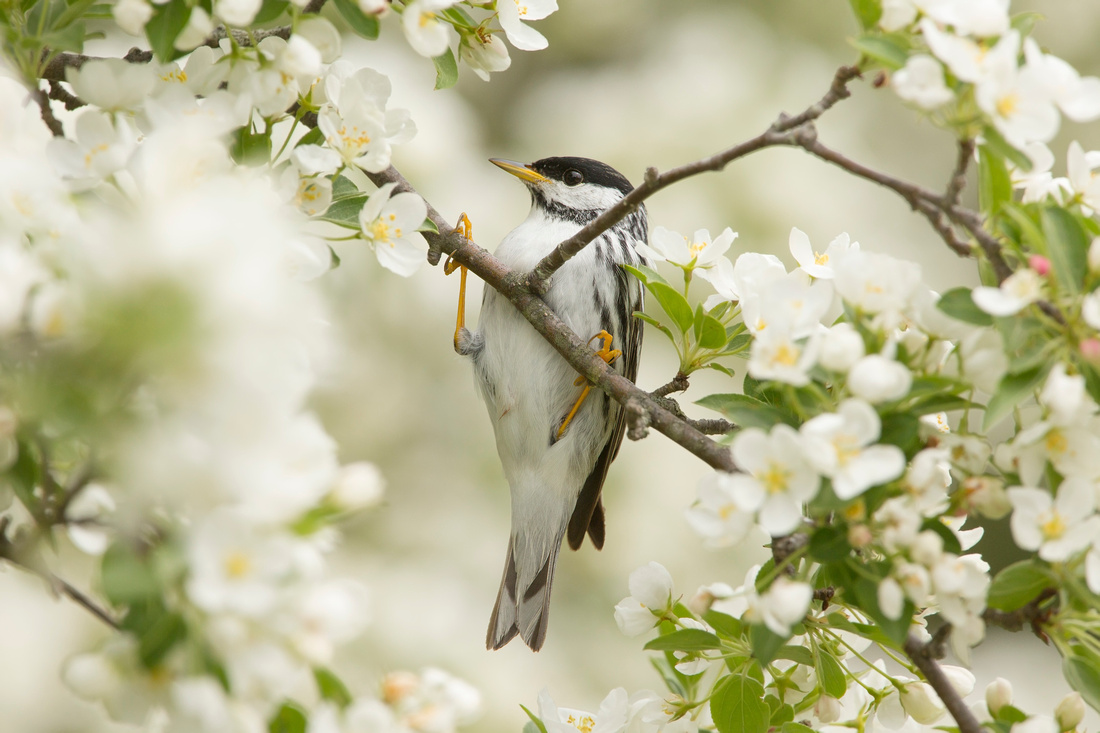

or do I go the front window and shoot the Magnolia Warbler in the pink tree?


I can't remember many times where I had to make so many "tough calls". Not to worry though, it only lasted a couple days. One thing that's certain is that this season with the yardbirds was definitely not ordinary.
A SHOCK TO THE SYSTEM
This winter has had it's share of cold snaps, bringing new terms like "polar vortex" to our collective vocabulary. It seems that the weather is overly dramatized more and more each year by meteorologists looking to build hype and drive up their ratings. There are usually a few times each winter when it gets pretty cold, sometimes even below zero, which doesn't stop me from going outdoors. So in early January, when the temperatures plummeted, I didn't think too much of it despite the cries from weathermen (and women). I had been watching a Snowy Owl on Great Island in Old Lyme, and usually stopped a few times a week in the late afternoon to check on it. One night as I was driving to Great Island during the worst cold spell, I noticed hundreds of gulls flying around as I drove past the Black Hall River, a small tributary near the mouth of the Connecticut River. This was pretty unusual, but I didn't think too much of it and spent about a half an hour watching the owl with a couple other hardy birders in the bitter cold and wind. It was really unpleasant.
A few days later, a birder kayaking around Great Island for the Christmas Bird Count reported seeing dead striped bass at the south end of Great Island. Soon after, the source of the floating fish, and the huge flock of gulls I saw, became apparent when hundreds, if not thousands, of dead Striped Bass were found lining the banks of the Black Hall River. The DEEP responded and determined that the die-off was likely caused by the record cold weather.


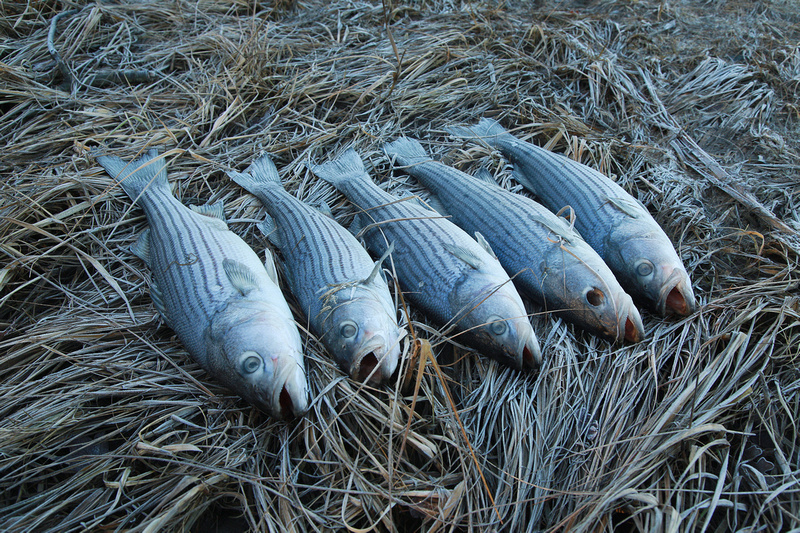

It's believed that the fish became trapped in the shallow water of the Black Hall, either by ice or low tides due to a coinciding new moon. The sudden onset of extremely cold weather combined with the fish being trapped in the shallow water resulted in a condition called cold shock, that caused a massive fish kill. A smaller die-off in the river was reported a few years earlier after a similar cold spell. As the news got out, I stopped by the river at the Route 156 bridge to see the carnage for myself. It was awful to see so many beautiful fish strewn along the river bank, many with their eyes pecked out. Farther up the river I saw more than a hundred dead fish in one spot at low tide, piled up on the bank near a bend in the river. I'm sure there were many more in areas I couldn't access, based on the huge flocks of birds gathered there.


As sad as the fish kill was, it was apparently a natural occurrence, and nature has a way of cleaning up its messes. In the weeks after the die-off, the decaying fish provided a seemingly endless bounty of food for the birds. Large flocks of gulls gathered to feed on the carcasses scattered along the river bank. There were hundreds of gulls and as several immature Bald Eagles concentrated in areas at the mouth of the river near Great Island and Griswold Point and upstream from the Route 156 bridge, attracted by the unexpected banquet.


As the dead fish along the river bank were exhausted, the gulls would gather noisily near sand bars and mud banks at low tide to feed on the fish exposed by the receding water. Great Black-backed Gulls and Herring Gulls dominated, and although there was plenty of food for all, they often fought noisily over each fish.




When those fish ran out the gulls resorted to dragging the seemingly endless fish carcasses from the shallow water onto ice floes or sand banks and just kept eating.


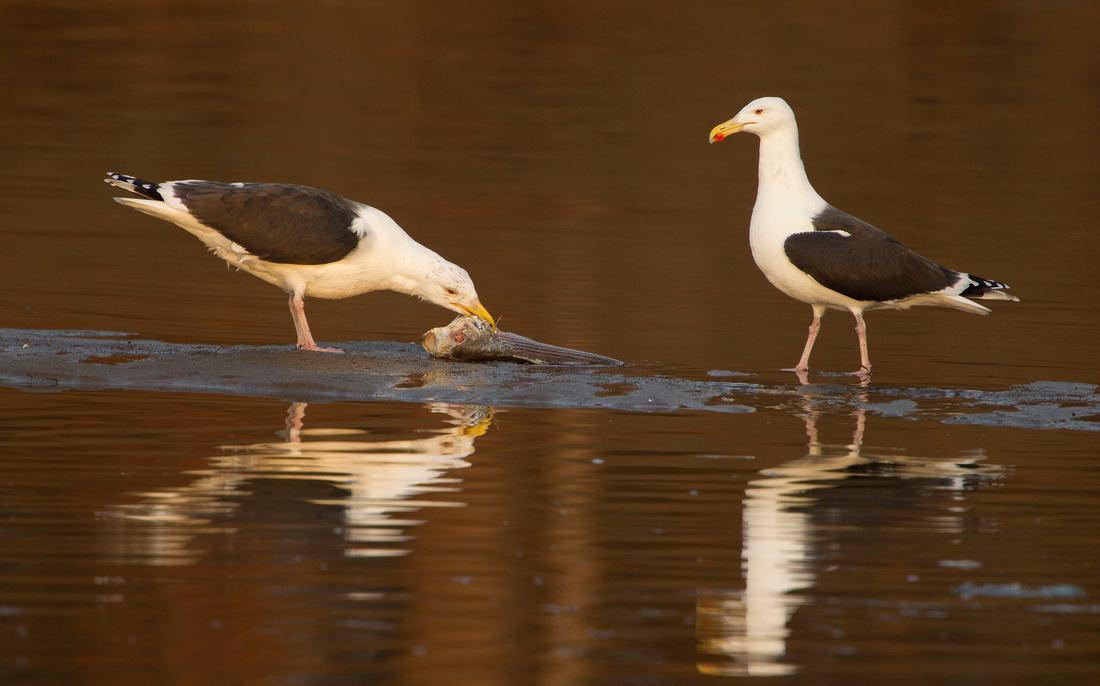

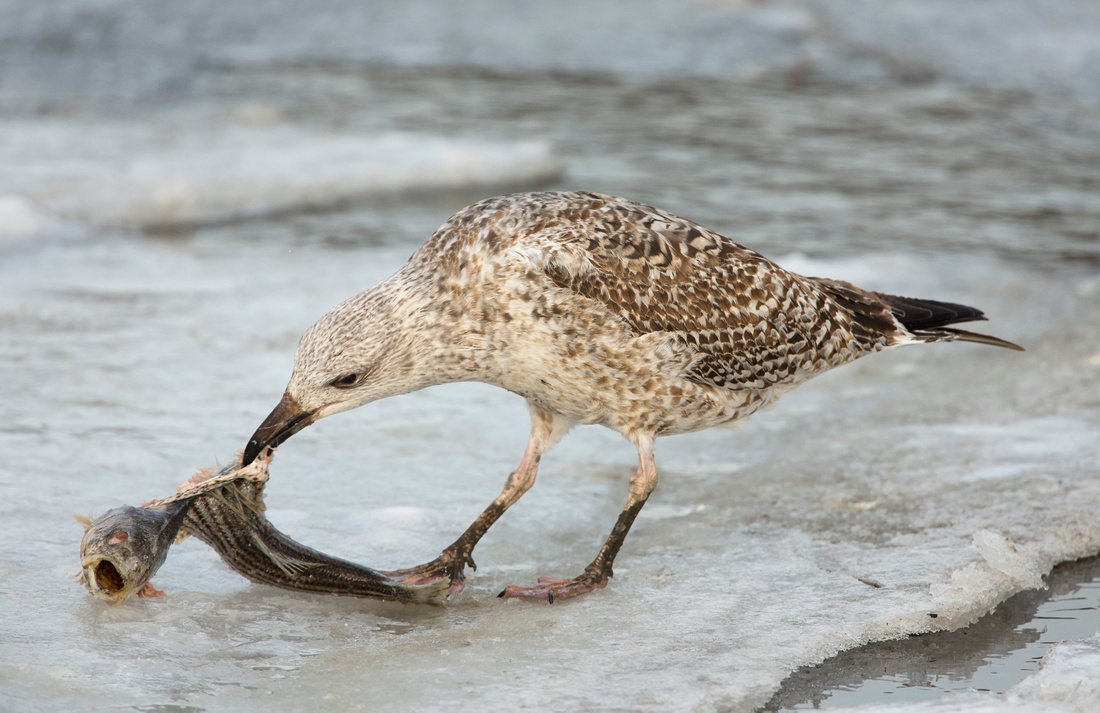

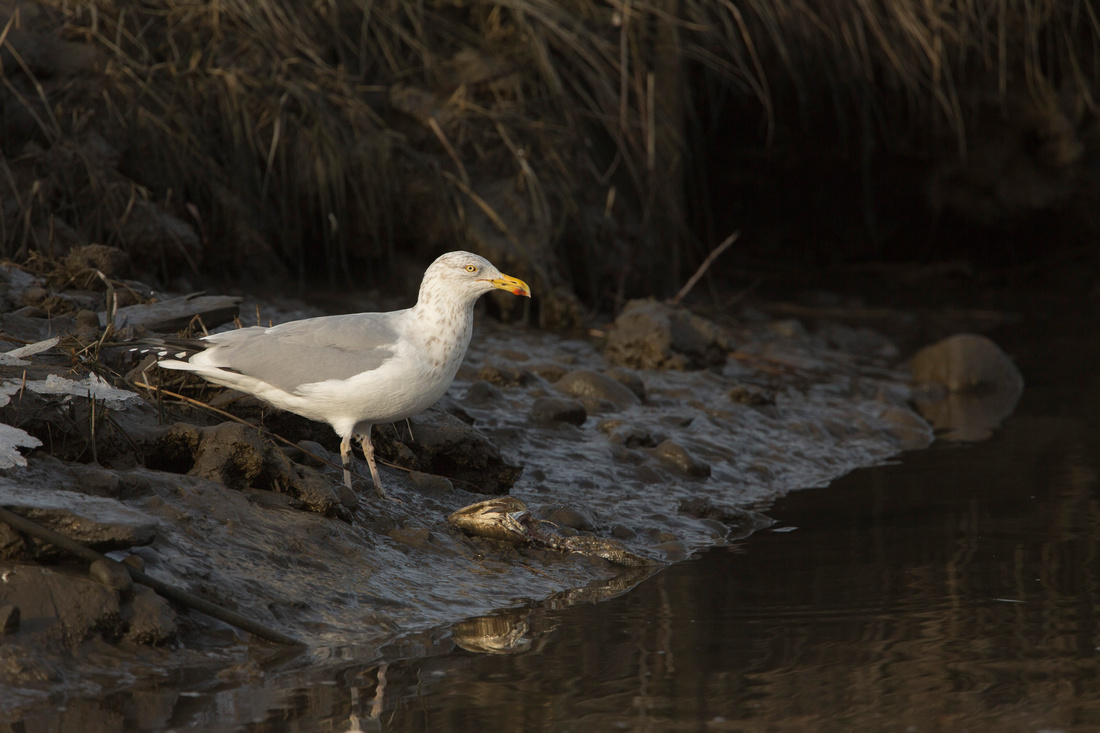



While the flock of gulls remained constant, the number of Bald Eagles on the Black Hall River began to build over the first few weeks of the bounty. At first I saw four young eagles feeding on an ice floe (presumably on the dead fish) near at the mouth of the Connecticut River. Early on, about half a dozen immature eagles congregated near the mouth of the river. As their numbers slowly built, the young eagles could be seen flying around upstream from the Route 156 Bridge, often chasing each other and perching in the tall pines on the bank of the Black Hall River.
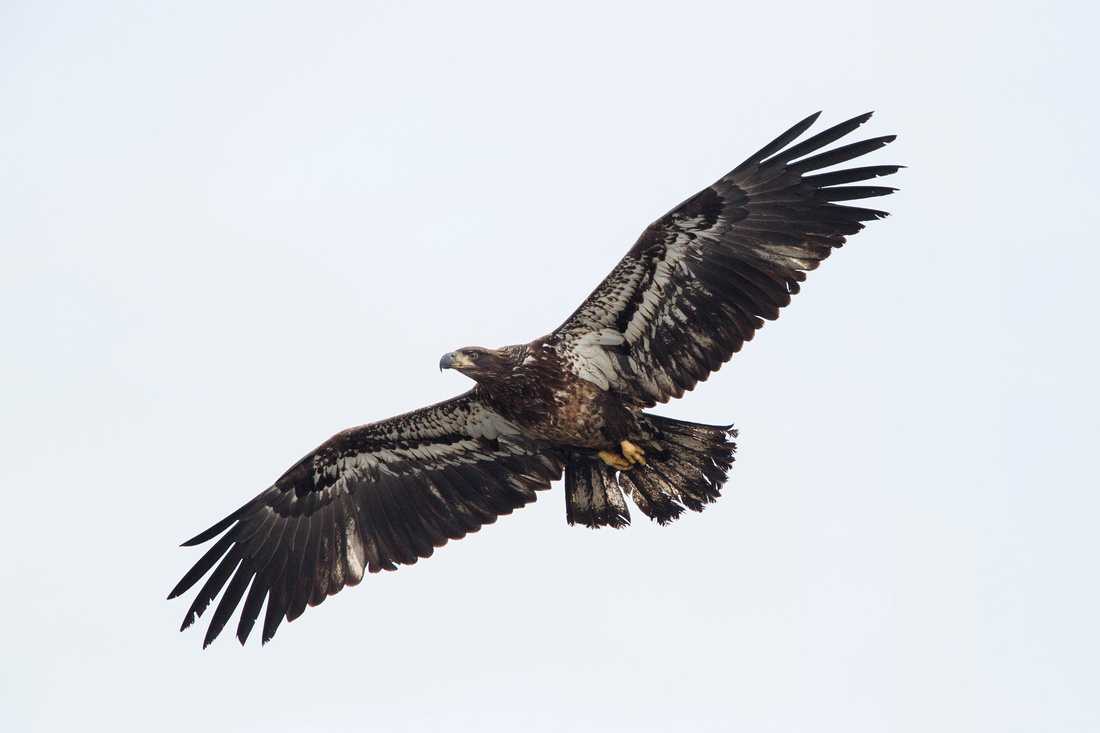



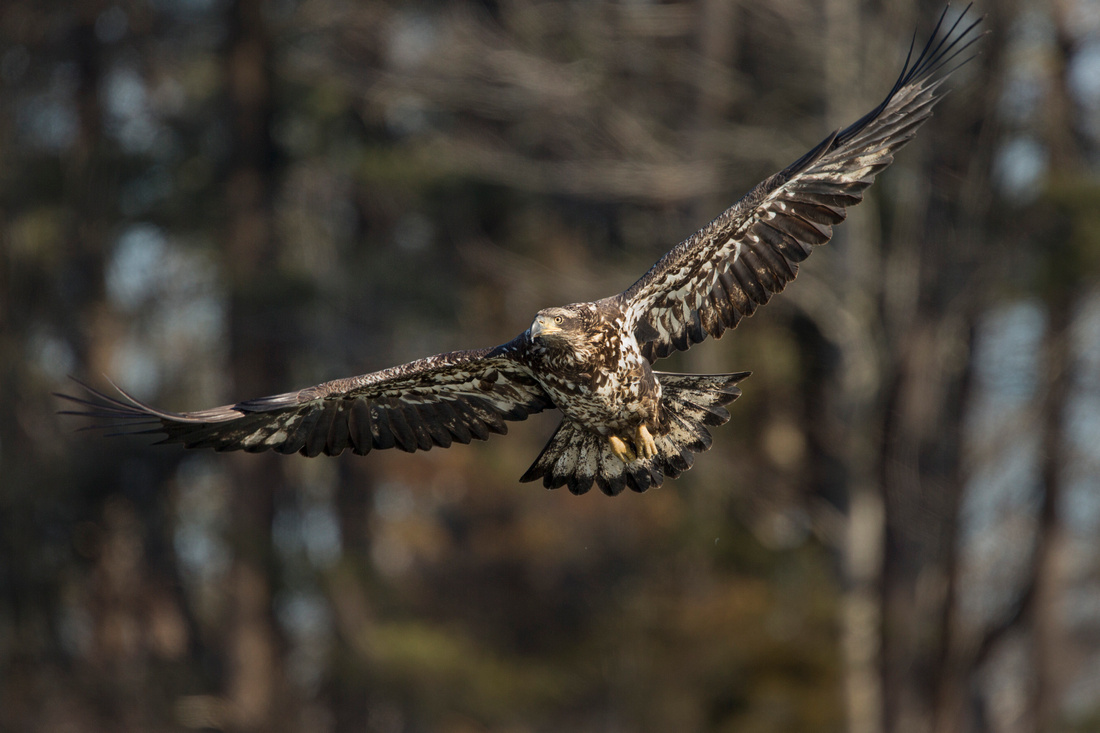

Once in a while all the gulls would suddenly take flight and a young eagle would swoop down to the water, grab a fish and fly off with it.
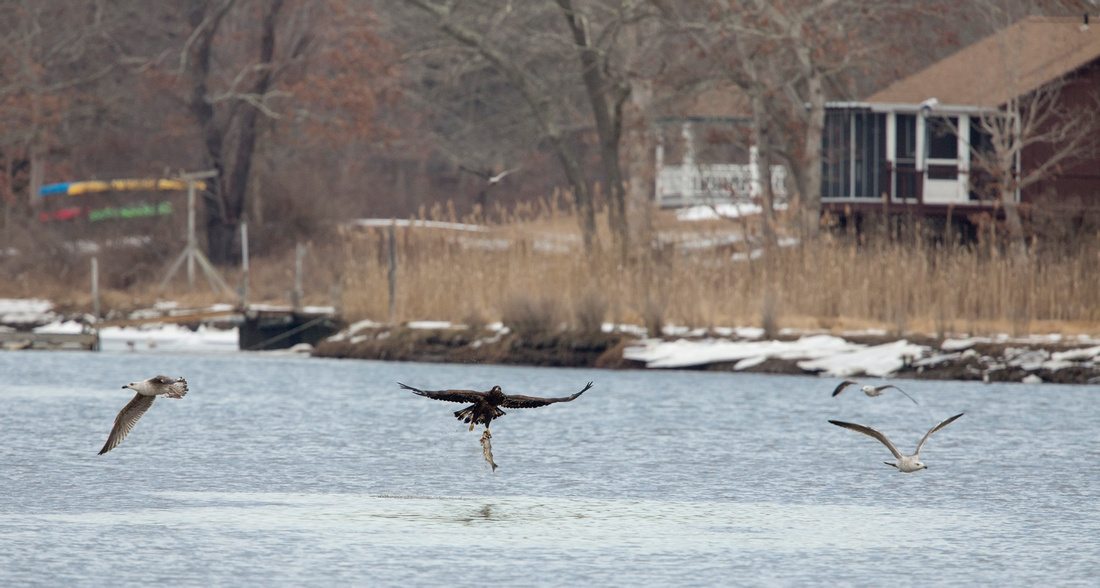

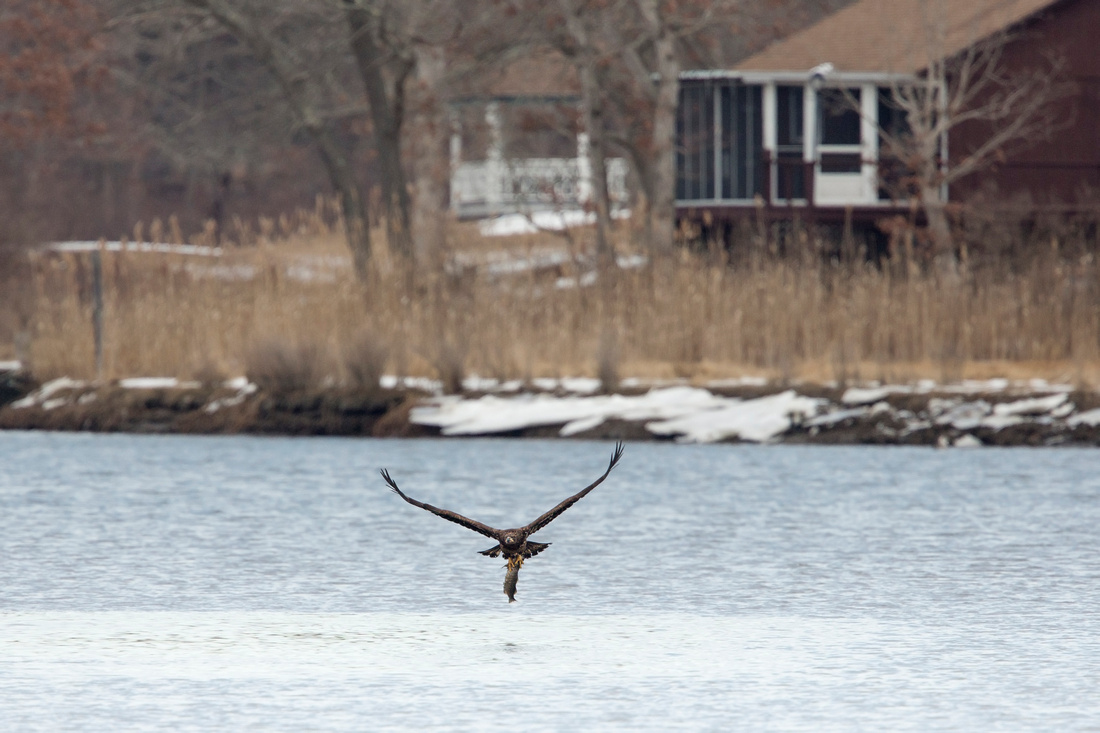

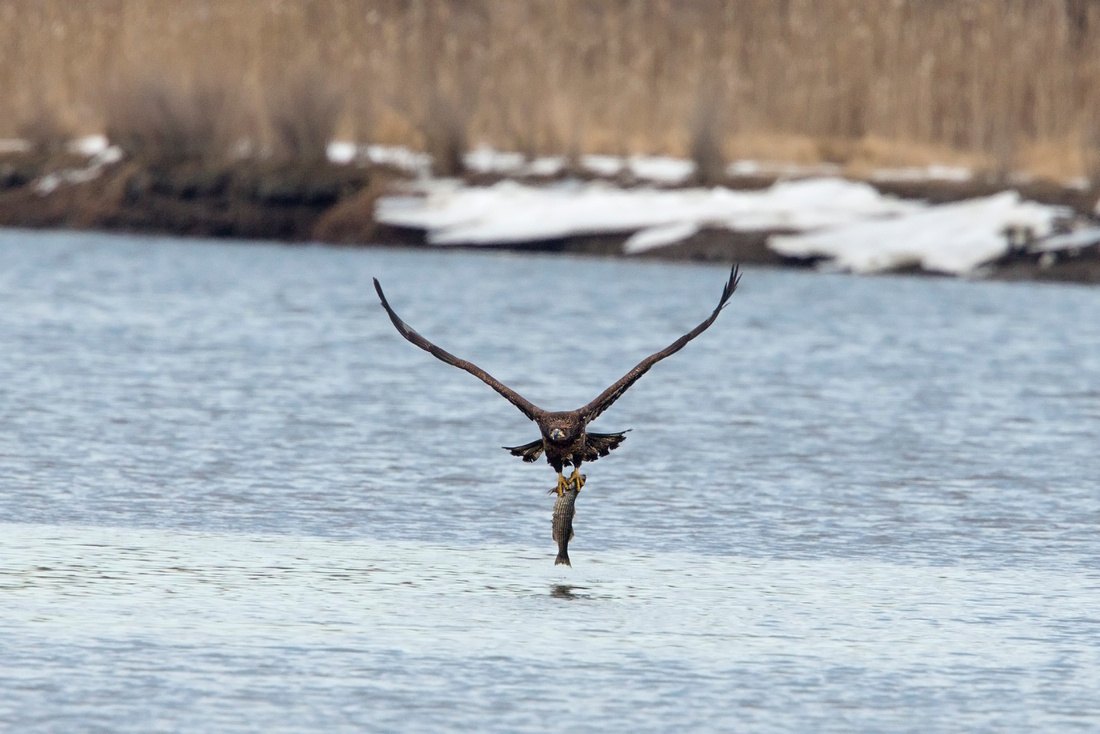



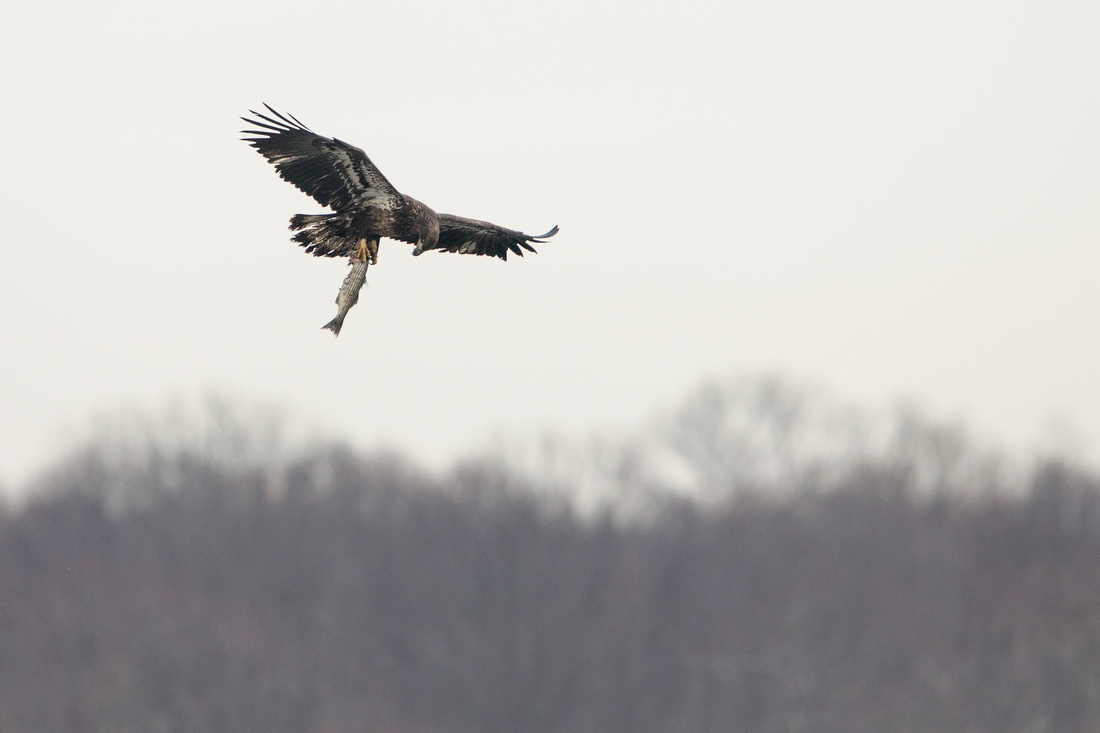

It's been more than a month now since the fish kill and there are still plenty of dead fish for the taking. The well fed gulls continue their noisy feast and the number of Bald Eagles has grown to more than two dozen. Last week, after one of the snow storms I drove by the river early in the morning and counted at least 15 immature eagles roosting in a single stretch of woods, their dark shapes standing out against the snow covered branches. It was the kind of scene you'd expect to see in Alaska, not in Connecticut. Unfortunately, they were too far off for a good picture. There are also two adult eagles frequenting the area.
Another interesting thing was that I kept seeing Red-shouldered Hawks perched out in the open in trees along the river bank, forsaking their normal woodland habitat. One morning I discovered that they, too, were taking full advantage of the all-you-can-eat seafood buffet. I watched a hawk spend nearly 45 minutes eating a fish on a gravel bar, completely stripping the carcass of flesh.
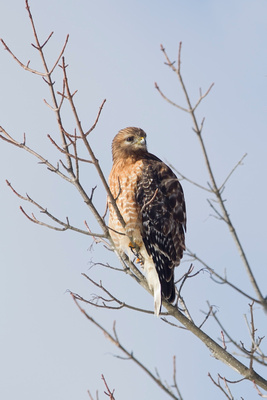

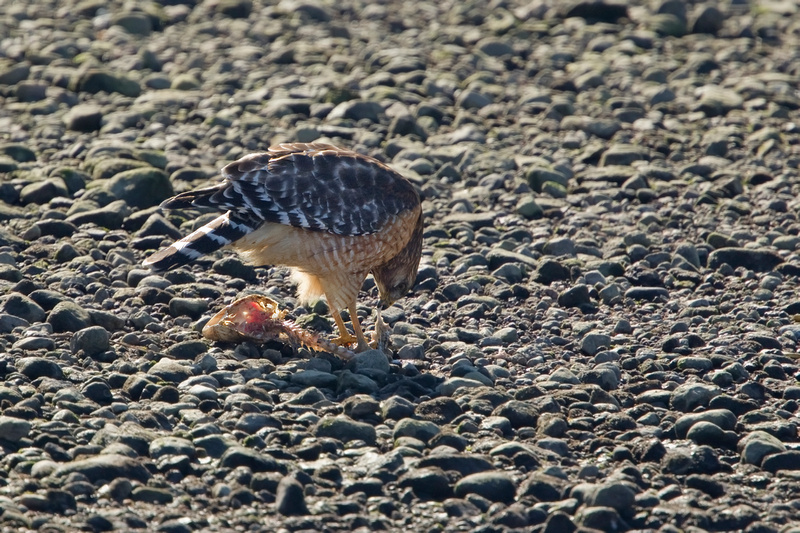

Nature can be pretty harsh, and the death of so many healthy young fish is sad to see. Hopefully the die-off won't seriously deplete the Striped Bass population in our waters. As cruel as it can be, though, nature also has a way of balancing things out, and the dead fish have turned a cold, harsh winter into a time of plenty for the many birds who have gathered at the Black Hall River.
A SNOWY WINTER - PART 2 (The Show Must Go On)
Once the novelty of this record setting Snowy Owl invasion into the region started to subside, and the owls settled into spots where they could be found consistently, the real fun started. Having the Snowies around and in reliable locations for a good part of the winter has not only created many more photo possibilities than any other year I remember, but also allowed a lot more opportunity to watch them in action and get a better sense of their behavior. I think that knowing your subjects well is one of the most important factors in improving a wildlife photographer's results, and believe my own experience bears this out.


Many photographers ask me about my camera equipment, and I get the sense that some think that having the newest and best equipment will automatically make them better photographers. I was already a working photographer with professional gear when I started photographing birds (my first official bird picture, at left, was a Short-eared Owl), but many of my early attempts were pretty bad. That my results have improved over time, I think, has more to do with an increased knowledge of birds rather than the level of equipment I use, which has stayed relatively consistent. Think of any other trade or skill, like a carpenter or musician. Buying the best tools or an expensive instrument wont instantly make you better at it, it takes time and practice and a good knowledge your subject. So having a chance to study and learn about a bird, especially one as uncommon and beautiful as a Snowy Owl, is a rare opportunity and is one not to be missed.
The closest area to me where Snowy Owls have been seen regularly is Great Island in Old Lyme, and since it's only ten minutes from home I check there often. The first owl was found there just before Thanksgiving by Old Lyme birder Hank Golet. For a few days birders saw it there, occasionally being harassed by a resident pair of Peregrines, before it disappeared. Hank later spotted one in Old Saybrook on the breakwater near the Saybrook Point Lighthouse. That spot is only a short flight from Great Island, and by Christmas he reported one back on the island.

 Late one afternoon as I drove down to the Great Island boat launch I was surprised to find the small parking lot full of cars and at nearly a dozen people on the viewing platform. Hank had his scope trained on the Snowy Owl on the far side of the island and the people took turns looking at, their excitement obvious. Soon anther was spotted on the near side of the island, across from Griswold Point, offering much closer views. The crowd was exuberant, especially when the sun began to set and the owls began to stir, flying between the Osprey nesting platforms. A family with young children arrived, hoping to watch the sunset, and wondered what the attraction was. They were obviously not birders, but seemed genuinely gleeful to see the owl show. The crowd was then treated to a spectacular view as the owls flew north on the island, the closer one passing right by the platform in the dusky pink sky.
Late one afternoon as I drove down to the Great Island boat launch I was surprised to find the small parking lot full of cars and at nearly a dozen people on the viewing platform. Hank had his scope trained on the Snowy Owl on the far side of the island and the people took turns looking at, their excitement obvious. Soon anther was spotted on the near side of the island, across from Griswold Point, offering much closer views. The crowd was exuberant, especially when the sun began to set and the owls began to stir, flying between the Osprey nesting platforms. A family with young children arrived, hoping to watch the sunset, and wondered what the attraction was. They were obviously not birders, but seemed genuinely gleeful to see the owl show. The crowd was then treated to a spectacular view as the owls flew north on the island, the closer one passing right by the platform in the dusky pink sky.
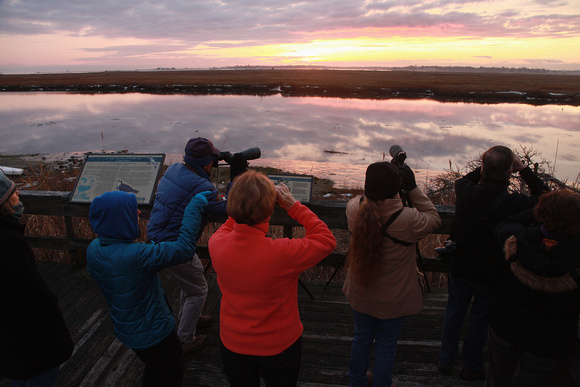

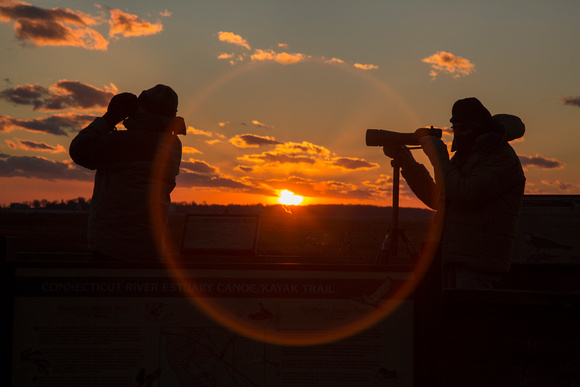

The afternoon owl show at Great Island became an almost nightly event, although one of the owls quickly moved on. Modest crowds would attend in nice weather and usually just a few diehards when the frigid cold arrived. Most nights the owl could be found near the beach on the opposite side of the island, and would begin flying up to the platforms around sunset like clockwork. Once or twice I saw it out on Griswold Point , but only when duck hunters and dog walkers were not present. Because the owl was so far away, it was not worth taking pictures. Occasionally, a Short-eared Owl made an appearance there, especially during the cold spells. It seemed to hunt the area closer to the boat launch, away from the area where the Snowy was, where I was able to get some pictures of it one day.

 Since getting good pictures of the Snowy Owl at Great Island was unlikely, I had to travel a bit to find locations where they were more accessible. The beaches of Long Island were the most promising. As I wrote in my previous post, I went there one day with a friend and we saw five owls in the dunes, but there were also lots of photographers there. I got plenty of pictures of the owls sitting on the dunes, and quite a few of them flying up and down the beach, the latter because some people were a little over zealous in their efforts to photograph the owls.
Since getting good pictures of the Snowy Owl at Great Island was unlikely, I had to travel a bit to find locations where they were more accessible. The beaches of Long Island were the most promising. As I wrote in my previous post, I went there one day with a friend and we saw five owls in the dunes, but there were also lots of photographers there. I got plenty of pictures of the owls sitting on the dunes, and quite a few of them flying up and down the beach, the latter because some people were a little over zealous in their efforts to photograph the owls.
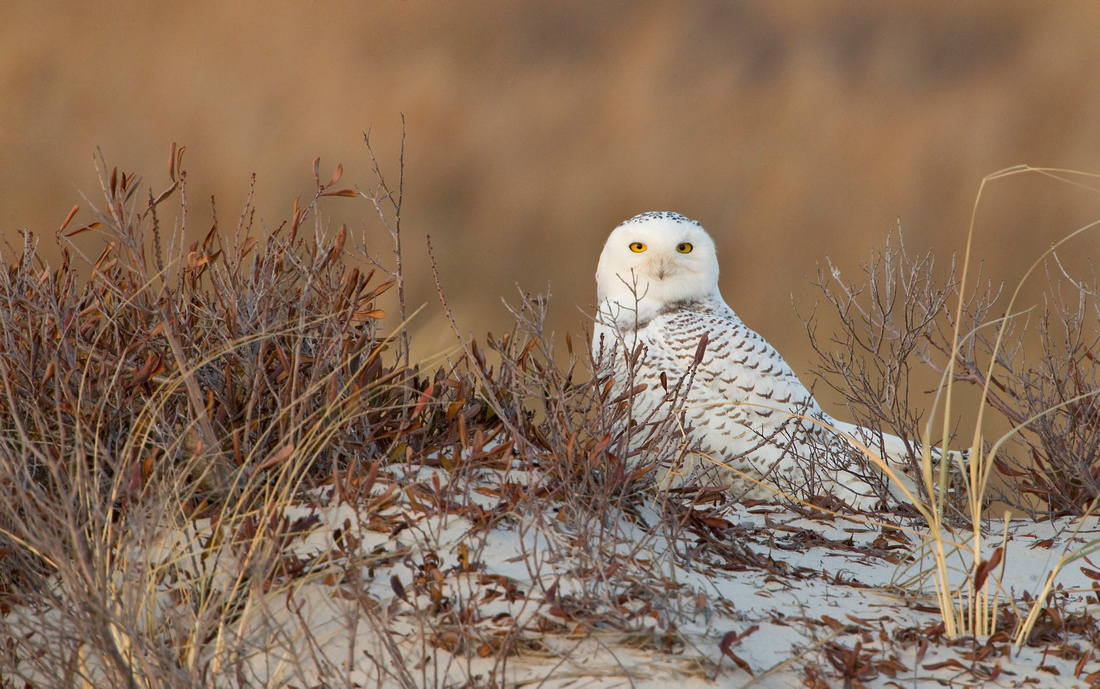



I considered going back there when things quieted down a bit, and still may, but it's a long trip for me and I'd rather work areas closer to home. Snowies have been seen at Hammonasset, but the sightings are sporadic and usually pretty distant, as well. One bitterly cold and windy day I watched an owl as it slept on the roof of a pavilion near West Beach. I decided not to bother photographing it because of the location, but was amused to watch as it fended off repeated dives by a Merlin with raised wings. A couple other times I watched an owl out on the beach from the end of the Cedar Island Trail, but it was too far for photographs. On those occasions, I had to leave just when the owl started to stir in the late afternoon because the park was closing (one of the big drawbacks to Connecticut parks).
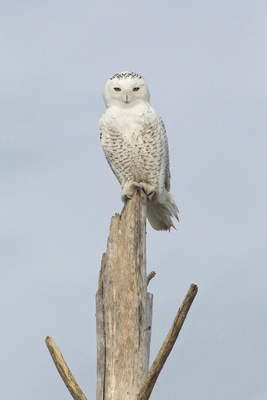



Many of the best spots to see Snowy Owls in Connecticut are in the western half of the state. At Long Beach in December I was able to get some pictures of an owl perching on different trees, along with some shots of the mud covered owl from the last post. After visiting a couple spots in western Connecticut and several in Rhode Island, I decided to concentrate my efforts in our neighboring state since the opportunities seemed more plentiful and the distance for me to travel was about the same.
My usual route took me through Westerly, Charlestown and West Kingston in the morning and then Jamestown and Middletown in the afternoon. In November I was able to get some pictures of Snowy Owls at the Charlestown Breechway and at Sachuest Point National Wildlife Refuge in Middletown. Later I saw them in Westerly, near Misquamicut Beach and at Beavertail State Park in Jamestown, but picture wise the best results were at Sachuest.
When they first arrived, the owls at Sachuest mostly stayed on the rocks near the southeastern shore of Aquidneck Island, where the refuge is located. There were as many as four Snowy Owls there. After several weeks some were reported near the parking area and visitor's center, hunting in the open fields in the early morning and late afternoon. Sachuest quickly became the best location for the owls.
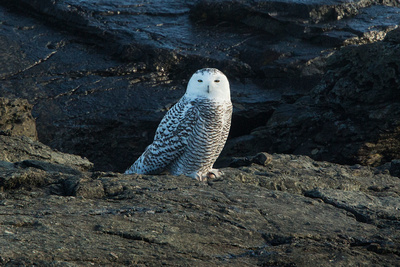

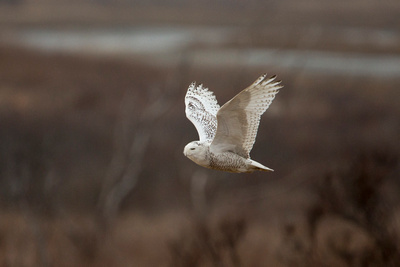

Some people were able to photograph owls near the parking lot with rabbits or other prey, although I was not so fortunate. One afternoon a Snowy hung out in the grass near the parking area, at times near a herd of deer, drawing big crowds of spectators. Just after the sun set, it flew out over the field adjacent to the parking lot and began hunting, hovering in place like a Rough-legged Hawk in the strong wind.
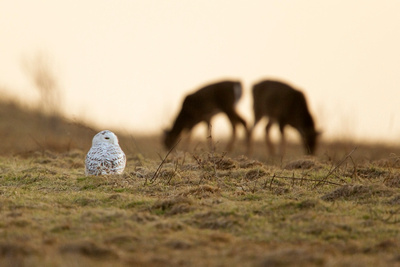



Another night, while leaving the refuge, I saw the silhouette of an owl on the dunes at Sachuest Beach. I was able to pull into the parking lot and watch and photograph as it prepared for its evening of hunting in the orange afterglow.


One day I pulled into the parking lot at Sachuest Point in the mid-afternoon and got out of my car. I immediately spotted a tawny bird flying in the adjacent field which I thought was a Northern Harrier, which are common there, or Short-eared Owl. I grabbed my camera and started shooting the bird, which to my great surprise turned out to be a Barn Owl.
I was able to get pictures as it worked its way through the upper fields near the parking area and down to the capped landfill, then back to the top. For nearly an hour it hunted, diving to the ground for prey, and after a few minutes flying up to continue its search.
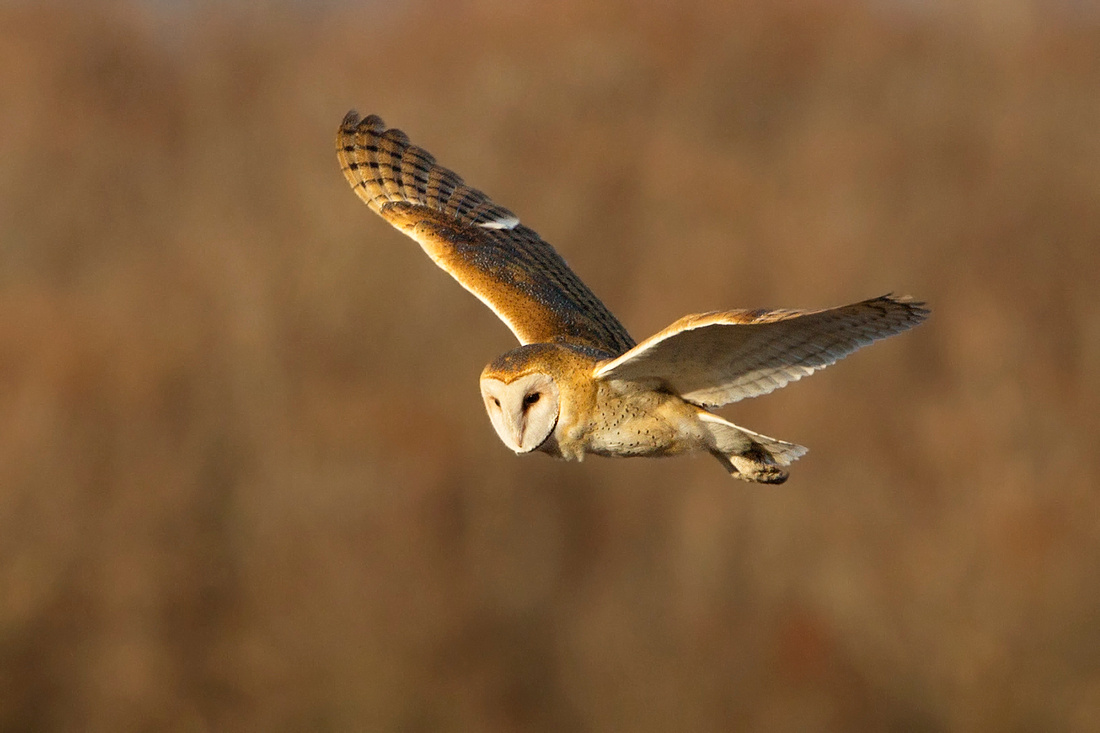



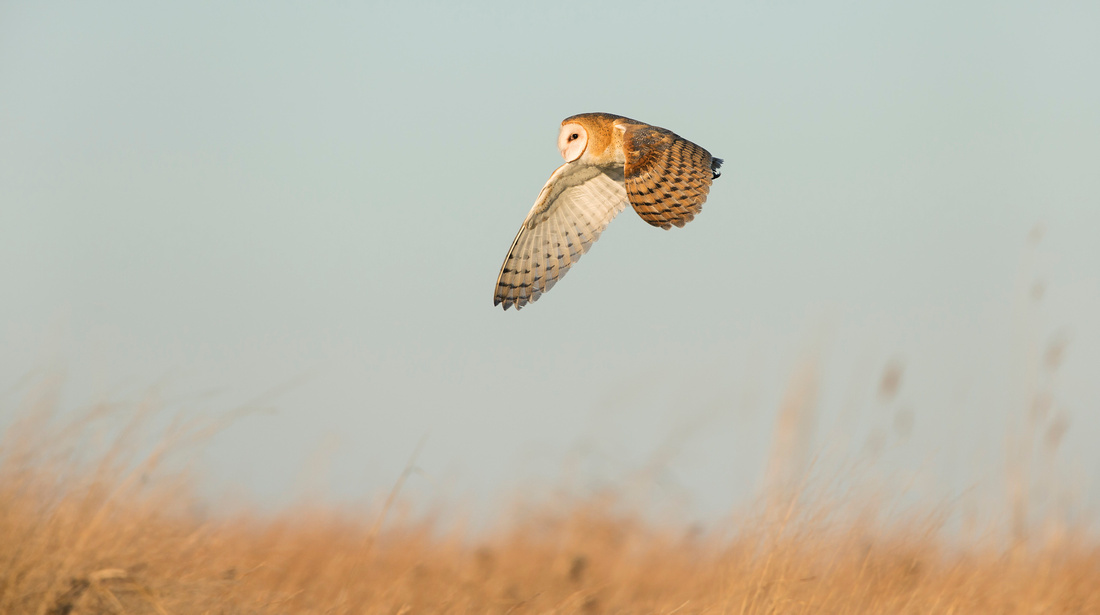

It turns out that the Barn Owl had been seen for a few days, although the word was slow to get out. It became a somewhat of a regular, coming out in the late afternoon most days, hunting near the parking lot. Soon the Barn Owl became as big an attraction as the Snowy Owls, drawing crowds of birders and photographers on a nightly basis, especially on weekends when the parking lot overflowed and dozens of birders and photographers lined the fences waiting for the owls to appear.


I tried to visit at least once a week to take advantage of the opportunity. Talking to some of the local birders, I learned that another Barn Owl had been found dead earlier in the winter, apparently killed and eaten by a Snowy Owl. Every time I watched it, the Barn Owl seemed to hunt with an amazing success rate and little disturbance from the Snowy Owls or any other raptors, save for the occasional arial duel with a passing harrier. The refuge seemed to be a haven for birds of prey, and in addition to the Barn and Snowy Owls, there were several Northern Harriers, a Merlin, a Peregrine Falcon, a Coopers Hawk and a Red-tailed Hawk all frequenting the area.
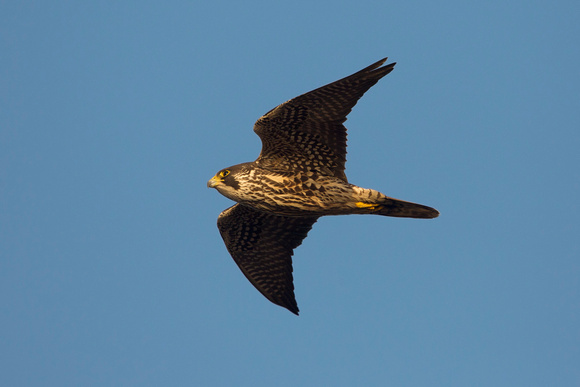

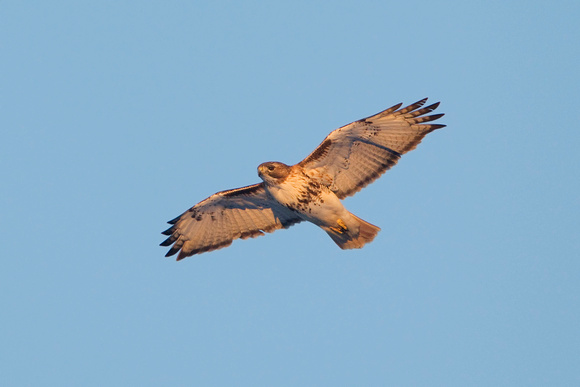

TROUBLE IN PARADISE - I recently had a free afternoon and decided to head to Sachuest Point, hoping for an encore performance. When I arrived there were a group of photographers in the parking lot, looking rather grim. I was told that two days earlier some one reported seeing the Barn Owl being attacked in mid-air by a Snowy Owl and knocked to the ground. When it tried to fly away it was chased and knocked to the ground again by a harrier, and had not been seen since. We waited for a while, and as the light faded without any sighting of the Barn Owl, so did our hopes of seeing it again. We walked around to other fields near the visitor's center, without luck, so I headed back to the parking lot. From there I saw a Snowy Owl in the lower fields take flight and make a bee line for the field that I just left. I tried to alert a few other photographers walking back from the field that the owl was headed their way. They turned to see it speeding across the field and saw the Barn Owl take flight from the grass heading towards a nearby stand of cedar trees where it apparently roosted by day, with the Snowy in hot pursuit. By the time I got around the visitor's center I could see a harrier diving into the cedars as the Barn Owl ducked into the lower branches for cover. The Snowy returned and perched atop one of the cedars while the harrier dove at it repeatedly. The Snowy Owl stayed perched on the cedar tree, as if lying in wait for the Barn Owl, flying out once to duel with another Snowy passing the area, then returning to its perch.
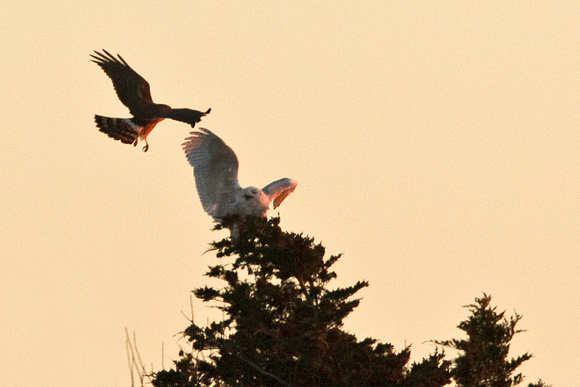



It's unclear what has caused the the sudden change in harmony and the resulting drama. Back in the parking lot another photographer who stayed in the field showed us a distant picture he got of the Barn Owl sitting in the grass eating a mouse before the Snowy chased it. Everyone was happy to see it alive and still able to hunt, but for how long will the show go on?
A SNOWY WINTER - PART 1 (The Good, The Bad and the Ugly)
The winter of 2013-14 will be remembered as a very snowy winter in the Northeast, no matter how many storms we get and how many inches fall. It's been one of the greatest Snowy Owl irruption years in decades for the region. It's hard to determine just how many owls are here, but the numbers are unprecedented for the 20+ years that I've been birding.
THE GOOD - In Connecticut alone there have likely been at least a dozen different owls this year, mostly along the shoreline, although it's difficult to pin down because they may be moving around. There have been sightings from Groton to Greenwich with as many as four seen at one location in Stratford. In Rhode Island, it's a similar story and I've seen owls (in some cases multiple owls) in Westerly, Charlestown, South Kingstown, Jamestown and Middletown. In New York, there were five different Snowies on a single stretch of Long Island beach. And in Massachusetts birders have reported seeing eight different owls at one time on the North Shore. The most amazing report I've heard is from NewFoundland, where a researcher counted 75 in one location and more than 200 in a single day. Snowy Owls have been reported all the way down the eastern seaboard, as far south as Florida and Bermuda and into the midwest. The invasion is so impressive that EBird has a special section just for Snowy Owl information. http://ebird.org/content/ebird/news/gotsnowies2013/
Having so many Snowy Owls around has made this an interesting and exciting winter for birders and photographers, myself included. With so many people getting out to see and photograph the Snowies there have been some other great finds, including some other cool owls. Here are my observations from this "snowy" winter.
The first Snowy Owls started showing up in southern New England a little before Thanksgiving. My first sighting of the season was a darkly barred immature female in Charlestown, RI on November 26th, and one was found in Connecticut the same day.
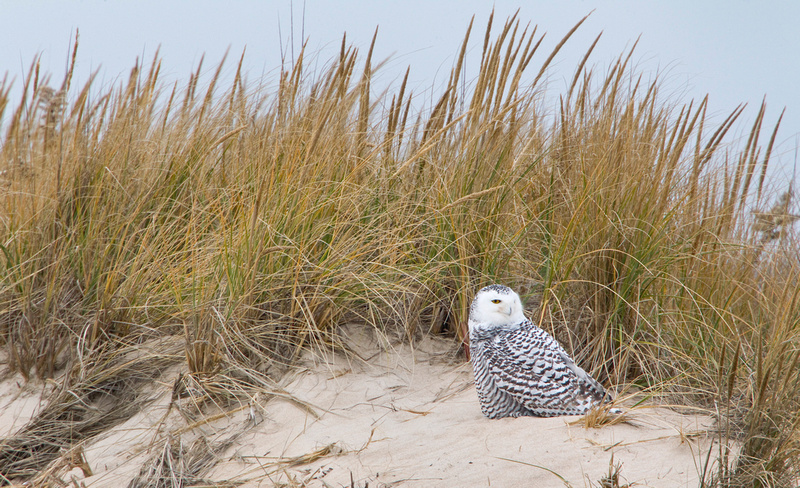

A few days later I went back to Charlestown and saw three Snowies at the end of East Beach, at times getting pushed around by fisherman and off-roaders who frequent the area. It seemed like more owls were showing up every day.








Later that afternoon I went to Sachuest Point NWR in Middletown, Rhode Island where at least two more Snowy Owls were seen. There were dozens of people constantly stopping to look at one of the owls perched on the rocky shoreline. The word was out and there were lot's of birders and photographers, but also many hikers who were just out for a walk who were excited to see a white owl. Most were happy to watch from a distance, but with so many people eager to see and photograph them, the pressure on the owls mounted. Around the Northeast the rift between birders and photographers ignited almost immediately.
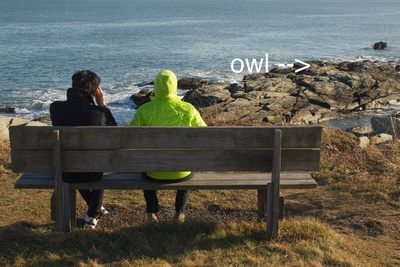



THE BAD -The birder vs. photographer battle has gone on for a long time, and owl sightings are almost always a fuse that ignites an explosion. Initial reaction by some birders that all the Snowy Owls here are starving, near death and unable to withstand any disturbance are often overblown, in my opinion. Surely, some of them are in desperate shape, and may not survive, but this is likely to be the case even without human disturbance. In nature, a large percentage of young birds, especially birds of prey, do not survive their first year. Human disturbance of any kind might compound this. Unfortunately, though, some of the criticism of photographers in particular (I use the term to include anyone with a camera) is justified.
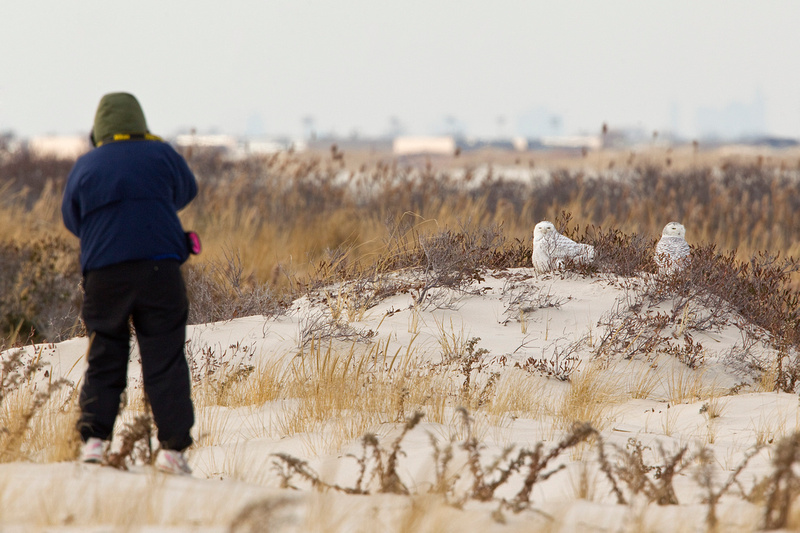

The picture above, from Long Island, is not intended to imply improper behavior. The photographer is farther a way from the owls than it appears as the distance is compressed by using a telephoto lens. As a photographer, I have felt the disapproval of some birders for getting too close to birds for a picture. With 20 years of experience and a telephoto lens, I think I can judge how close to approach birds and other wildlife for the best results, both mine and theirs, although I can't say that I've never flushed an owl. This year I've seen a lot of photographers' actions with the Snowy Owls, some deliberate and some due to inexperience, that hurt our cause. These are only my opinions.
With the explosion of digital photography, there are now many more people interested in photographing birds and wildlife, and therefore a lot more chances for disturbance. Some are new to birding and/or photography, and may lack the experience and judgement to act appropriately. Others are experienced birders or photographers who may feel their knowledge justifies "aggressive" photography. Whatever the circumstances, here are a few examples of "bad" behavior by photographers I've seen this winter.


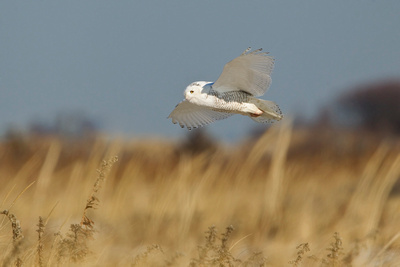

The most annoying example was on the trip I made with a friend to Long Island last month. There were five Snowy Owls (two pictured above) on one stretch of beach, and many photographers with big and small lenses were there to photograph them. The owls were a bit skittish, likely because there were a lot of people around. Competing for subjects can be frustrating for photographers, especially when some are inconsiderate of the others. One photographer with a shorter telephoto (300mm) repeatedly approached the owls too closely, causing them to fly off. I got a bunch of flight shots of owls that this photographer flushed from their perches and towards me. And when the owls landed near other photographers, he would immediately walk directly towards them, almost racing to get there first, cutting in front the others in the process. At first I thought he just didn't know what he was doing, but the more I watched, I believe he was doing it deliberately to get flight shots. Walking quickly toward the owls, raising his camera as he got close, ready to get them flying as he chased them away. Besides the obvious, that he had no concern for the birds, he also had no regard for the many other photographers there, either.
Another instance was in Stratford at Long Beach, where an unhealthy owl drew a crowd of spectators near the parking lot. This was the owl that I wrote about in my previous post that was all muddy. Although this owl did not fly off when several people approached it very closely, it was clearly disturbed when people began to walk all around it to photograph it from different angles. I'm not sure of the circumstances, but I believe someone in the group had contacted a rehabilitator (more than likely saving it's life) and were waiting for him to arrive. I'm sure their hearts were in the right place, and the picture is not intended to embarrass anyone, but surrounding an owl, or any wild bird or animal is likely to scare it.
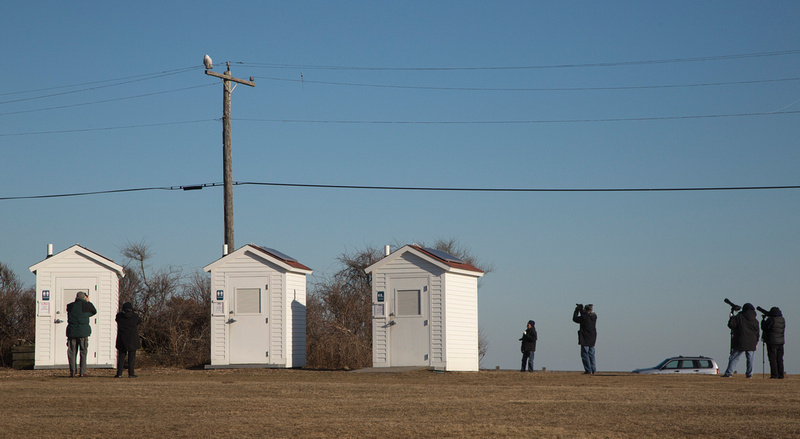

Another example of this was at Beavertail State Park in Rhode Island where a group surrounded an owl on a utility pole, photographing it from all different directions. It flew off to a lower perch closer to me, and some in the group hurried past me towards it, one exclaiming that boreal birds had no fear of people, sending it flying off again, of course. With so many people hoping to see and photograph the owls there are some common sense guidelines (that I try to follow) that will work better for the owls and photographers, and invite less criticism from those with the scopes and binoculars.
1. Move slowly and quietly, and if possible, stay low.
2. In a group, stay and move together, don't spread out or surround the bird
3. Don't get "too close"- Individual birds may react differently, but start shooting from a safe distance and gradually move closer as it allows. Don't be afraid to crop your photos and be realistic, you're not likely to get a tight portrait with your IPhone, although I've seen people try.
4. If an owls is perched or lands in front of another photographer, let them at least get a few pictures before you start to approach. Ask to move in if possible, and approach slowly and quietly from directly behind the other photographer. Don't cut in front without asking. Trust me, you won't miss a mortgage payment because you didn't get that killer owl shot.
5. Don't deliberately flush an owl to get flight shots. Don't try to alarm or startle it to get it to move or open it's eyes. Be patient and let sleeping owls lie, they'll wake up when the light gets nice.
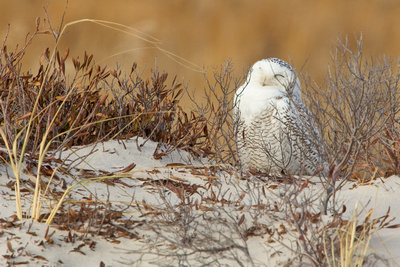



Okay, enough about the bad. It really shouldn't that long because it's been a really good time.
THE UGLY - With so many Snowies around, I've hoped to get that great close up picture of a perfect specimen in a spectacular natural setting and beautiful light, but so far it hasn't all come together. I see a lot of incredible pictures other photographers have taken, and keep hoping I'll get my chance. Ugly doesn't describe the owls I've photographed, except maybe the dirty owl at Long Beach in Stratford. It has more to do with the places some of them choose to perch. Most of the owls I've seen in ugly places I have not bothered to photograph. These include buildings, rooftops, light poles and messy beaches.


The only real pretty spot I've photographed a Snowy is on the dunes in Long Island. The Rhode Island beaches are nice, Connecticut less so and I have not even been to Massachusetts or beyond to see them. Many of the owls I've found, though, have unfortunately chosen some of the ugliest spots available to hang out. In Westerly, Rhode Island a Snowy spent a whole afternoon perched on a makeshift drive-in movie screen in a dirt lot across the street from Misquamicut Beach, only moving when the wind caused it to lose balance and almost fall off. The owls blood stained feathers only added to the ugly scene, although I guess that meant it had eaten recently.
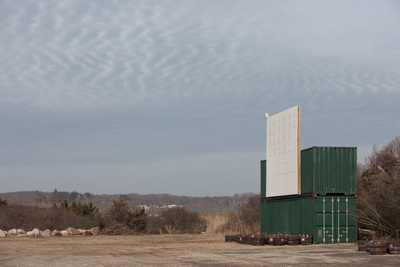



As the sun lowered in the sky and the bird woke up, I was hoping it would fly across the road to the beach or dunes, but instead it dropped down to the adjacent lot and perched on ....... yes, a beautiful water slide. Hard to get a nice shot in this setting.
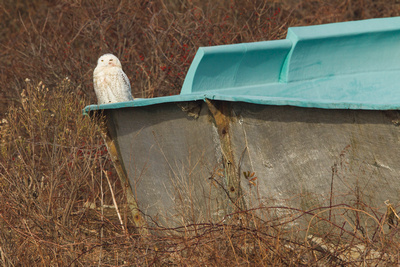

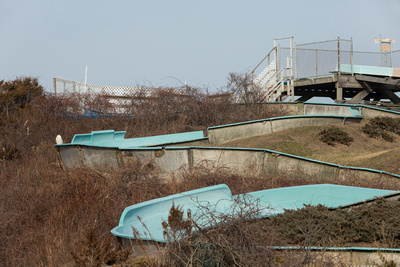

As I mentioned earlier, an owl was perched in the open at Beavertail State Park atop a utility pole near the bathrooms. It eventually flew to a perch right next to the lighthouse. Unfortunately, it chose a utility pole with a big, ugly transformer.




Although I have taken more pictures of the owls this year than in any other year, I'm still looking for that truly spectacular shot. Despite not having the photographic success I'd hoped for, it's been nice to have so many chances just to watch Snowy Owls in action. Since they are sticking around for the long haul, it's great that so many people have had a chance to watch the owl show, as well. Please check back soon for Part Two of this Snowy Winter.

